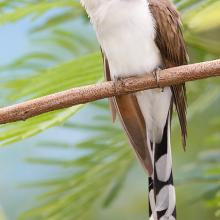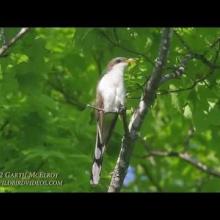

Join BirdNote tomorrow, November 30th!
Illustrator David Sibley and actor H. Jon Benjamin will face off in the bird illustration battle of the century during BirdNote's Year-end Celebration and Auction!
In addition to their scientific names, birds are also given "official" English names. Take the bird commonly known as the rain crow, for example, officially referred to as the Yellow-billed Cuckoo by the American Ornithological Society. Its scientific name is Coccyzus americanus. Of course, the bird doesn’t care what you call it, so long as it has plenty of hairy caterpillars to snack on.
BirdNote®
The Rain Crow - The Yellow-billed Cuckoo
Written by Rick Wright
This is BirdNote.
[Yellow-billed Cuckoo, ML 110253]
The call of the Yellow-billed Cuckoo may sound a bit like a car engine struggling to turn over before revving to life. But for generations and generations, people recognized these rattling gulps and hollow hoots as a precursor to something else — rain.
[Yellow-billed Cuckoo, ML 209326]
For people in the American Midwest, the bird was known as the rain crow, and its call was a sure sign of incoming weather. Of course, Midwesterners don’t rely on birds to predict the weather today. But in a part of the world where the clouds can open suddenly and drop anything from discomfort to devastation, the bizarre croaking on a summer afternoon can still inspire a shiver.
[Yellow-billed Cuckoo, ML 539858]
Unfortunately, over much of this bird’s wide range, the voice of the Yellow-billed Cuckoo is heard less and less frequently.
The open woodlands and riparian areas where they nest have been replaced by productive fields and tidy lawns. Pesticides are also to blame.
But in the undeveloped stretches of the Midwest, watch for the slinky, slender form of the cuckoo — and listen hard for the evocative voice of the rain crow.
[Yellow-billed Cuckoo, ML 539858]
For BirdNote, I’m Michael Stein.
###
Senior Producer: John Kessler
Production Manager: Allison Wilson
Editor: Ashley Ahearn
Producer: Mark Bramhill
Associate Producer: Ellen Blackstone
Bird sounds provided by The Macaulay Library of Natural Sounds at the Cornell Lab of Ornithology, Ithaca, New York. Yellow-billed Cuckoo, ML 539858, recorded by Wilbur L. Hershberger; Yellow-billed Cuckoo, ML 110253, recorded by Wilbur L. Hershberger; Yellow-billed Cuckoo, ML 209326, recorded by Julia Ferguson.
BirdNote’s theme was composed and played by Nancy Rumbel and John Kessler.
© 2021 BirdNote January 2021 Narrator: Michael Stein
ID# YBCU-03-2021-01-25 YBCU-03





